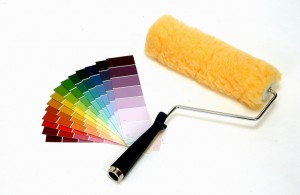 Color is the second most important thing in a space, second only to proper furniture and accessory placement. Color, especially through paint, is an affordable way to customize and personalize your rooms.
Color is the second most important thing in a space, second only to proper furniture and accessory placement. Color, especially through paint, is an affordable way to customize and personalize your rooms.
Let’s start by covering the elements of color with a few basic definitions.
Color/Hue – same thing and is the “title” we use to describe a color – blue, red or green for example.
Saturation – purity or intensity of color, how pure a color is. For example, a fully saturated color doesn’t have any white in it.
Value – the degree of lightness or darkness in a color, a color’s brightness as compared to white. A lighter color equals a higher value. When you are looking at most paint strips they are set up with one color per strip, shown in different values going up the strip.
Perfect color schemes-every time
Great information, right, but how do you use it to pick a paint color? Let’s start not by asking, “what is your favorite color?” but by asking, “what is your favorite saturation?” Here is a way to begin to select your favorite saturation.
Go to a paint store and select 4 paint strips all in the same color (let’s say green), but make sure they are in different saturations. Which saturation level are you drawn to? An individual is drawn to certain saturation more than a specific color. (Think about how many greens are out there!)
If you find your right saturation and stay within three values (dark to light, up and down on the paint strip) you will create a space that flows easily visually, makes a space appear larger, and complements furniture and accessories. For a powerful, high contrast space, keep values 5 – 6 apart.
It might take a color consultation with a professional to fine-tune your overall color pallet and to coordinate different rooms, but at least now you understand a bit more about how color “works.”
Bringing a Room Together with Color
Where to begin? It’s a common question and its best to start with an inspiration from your room-art, rug, sofa, bedding, etc. If you find a color you love in your inspiration piece take it and run with it. Find it on a paint strip and build a pallet around that color.
To add interest to a room, select three colors to use as your main pallet. When using the pallet in your room, break it into a 60%-30%-10% usage combination to create a room that is both visually interesting, yet not overwhelming to the eye.
Painting to Solve Your Room’s Problems
To make a high ceiling feel lower
If you have a room where the ceiling feels too high, paint it a darker color than the wall color. Really! It will bring the ceiling “down” and make it appear lower because darker colors advance walls (your ceiling is your fifth wall). You can also bring your ceiling color down onto the walls about 12″ and use crown molding in the room-it causes your eye to stop and therefore “interrupts” the height.
To make a low ceiling feel higher
If you have the opposite problem and you have a low ceiling that you want to “raise,” paint it one shade lighter than your wall color. Do not use crown molding, or if you have crown molding, paint it to match the walls so it disappears and keeps the line of the wall going up, creating height.
Make your room feel larger by avoiding strong contrast
White walls do not always make a room look larger. When the walls are closer in value to sofa (or large upholstered piece in the room), you tend to look beyond it, to the walls, enlarging the space visually. Also, use cool colors to open up your space. For example, if your walls are a burnt orange color and you want to open up the space, select window panels in the same or similar color versus a contrasting color.
Make your room feel smaller by adding contrast
The opposite is true for making a room feel smaller. Add contrast between your paint and large upholstered pieces and window treatments. This causes your eyes to stop and start and breaks up your visual field, making a space feel smaller. Also, using warm colors will advance the walls into the room, making it feel smaller.

